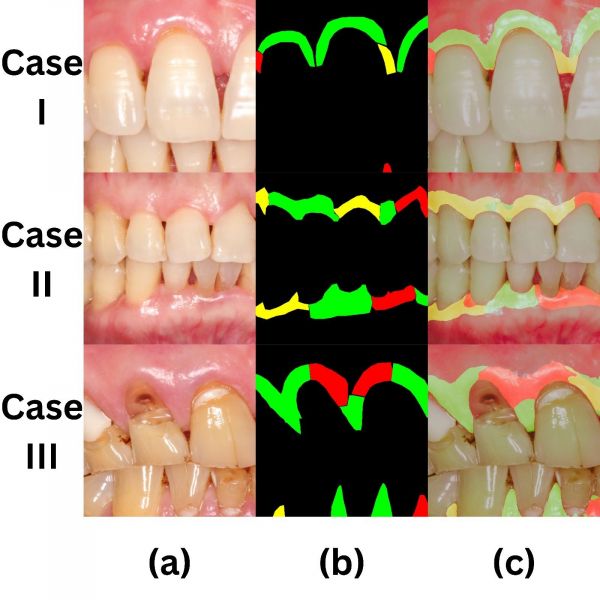- Best Practices New Normal
- Digital Dentistry
- Data Security
- Implants
- Catapult Education
- COVID-19
- Digital Imaging
- Laser Dentistry
- Restorative Dentistry
- Cosmetic Dentistry
- Periodontics
- Oral Care
- Evaluating Dental Materials
- Cement and Adhesives
- Equipment & Supplies
- Ergonomics
- Products
- Dentures
- Infection Control
- Orthodontics
- Technology
- Techniques
- Materials
- Emerging Research
- Pediatric Dentistry
- Endodontics
- Oral-Systemic Health
Researchers in Hong Kong Use AI for Early Detection of Gum Inflammation
Groundbreaking study demonstrates the use of AI in detecting gum inflammation from intraoral photographs.
Photo courtesy of Faculty of Dentistry, HKU.
Three cases illustrating dentist's visual examination (b) and AI's detection (c) of gum problems
(a) Intraoral photograph
(b) Health status labelled by a calibrated dentist (green=healthy, red=diseased, yellow=questionable) (c) AI detection results

Plenty of artificial intelligence (AI) solutions have been in the news in recent months, many of which offer improved x-ray diagnostics and front-office efficiencies. The potential for AI seems endless, and now research out of China indicates that the technology may soon play a key role in detecting periodontitis with intraoral imaging.
A groundbreaking study led by researchers at the Faculty of Dentistry of the University of Hong Kong (HKU), in collaboration with multiple international institutions has successfully demonstrated the use of AI in detecting gum inflammation, also known as gingivitis, from intraoral photographs. This cutting-edge technology can revolutionize early detection and prevention of oral and systemic diseases linked to gum inflammation, such as tooth loss, cardiovascular diseases, and diabetes.
The study, published in the prestigious International Dental Journal, an official journal of the World Dental Federation (FDI), shows that AI algorithms can analyze patients' intraoral photographs to detect signs of inflammation like redness, swelling, and bleeding along the gum margin with over 90% accuracy, matching the visual examination of a dentist. This technology enables population-wide monitoring of gum health and paves the way for more personalized dental care, according to the researchers.
Researchers from the HKU Faculty of Dentistry, the Department of Computer Science at Hong Kong Chu Hai College, the School of Information Engineering at Guangdong University of Technology, and the Faculty of Dentistry at The National University of Malaysia were behind the study. The effort involved developing and testing an AI model using a dataset of over 567 images of gums with varying degrees of inflammation and is one of the first to explore the use of AI in detecting gum inflammation.
Dr Walter Yu-Hang Lam, the study’s leading HKU researcher, emphasizes the significance of the findings for the early detection and management of gum disease.
"Many patients do not attend regular dental check-ups, and they only seek dentists to alleviate pain when their teeth are at the end stage of dental diseases, in which tooth loss is inevitable, and only expensive rehabilitative treatments are available,” he says. “Our study shows that AI can be a valuable screening tool in detecting and diagnosing gum disease, one of the key indicators of periodontal disease, allowing earlier intervention and better health outcomes for the population."
The use of AI in dentistry has been gaining momentum in recent years. Researchers have companies have been exploring various applications of the technology, from caries detection to predicting treatment outcomes to biomimetic design of artificial teeth. This use of AI in gum inflammation detection is a promising development that could revolutionize how gum disease is detected, treated, and even prevented.
Dr Reinhard Chun-Wang Chau, an HKU co-investigator of the team, points out the benefits of using intraoral photographs in conjunction with AI technology, saying, “Based on these intraoral photographs, patients can address the area that they did not clean well and seek dentists’ help at an earlier stage.”
By bringing together experts from different fields and regions—a strong example of interdisciplinary research and knowledge exchange—the researchers can develop an AI model that could accurately detect gum inflammation, with important implications for public health and wellbeing, according to the HKU team.
For the project’s next stage, Dr Lam plans to utilize the AI system for community services, making the technology more accessible to elderly and underserved communities, with the aim of improving oral health outcomes and reducing health disparities.
The study, Accuracy of Artificial Intelligence-Based Photographic Detection of Gingivitis, is available on the International Dental Journal.
The research team included educators from Faculty of Dentistry, the University of Hong Kong, Department of Computer Science, Hong Kong Chu Hai College, School of Information Engineering, Guangdong University of Technology, and Faculty of Dentistry, The National University of Malaysia.
